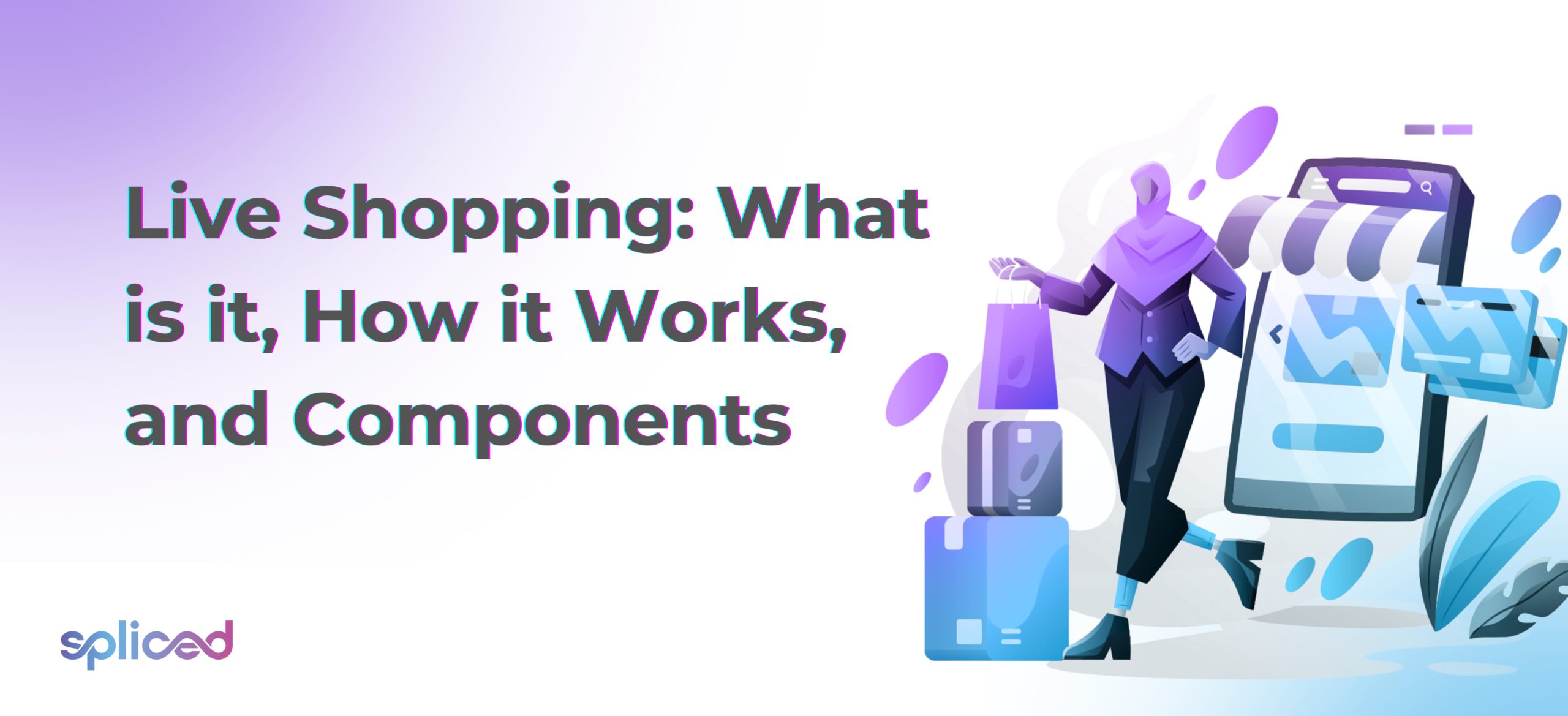Live shopping is a dynamic online retail model that utilizes online video broadcasts to link consumers and sellers. Live shopping is frequently termed e-commerce live streaming, livestream selling, or livestream shopping. The creative method incorporates the relief of internet buying with an in-person event’s tailored and fascinating encounter. Sellers talk about and show off their goods within a live shopping session, replying to viewers’ questions and giving special deals or discounts. An exciting and vibrant shopping experience is created by viewers who actively engage by posting comments, asking queries, and creating acquisitions in real-time.
Live shopping combines live video streaming to give visitors an exquisite shopping experience. Celebrities, influencers, or brand ambassadors usually present live shopping events. Sellers highlight features, advantages, and other pertinent product information while exhibiting them in real-time. Viewers interact with the presenter by asking questions, seeking clarification, and even demanding demonstrations. The audience and presenter develop trust and camaraderie via the in-the-moment connection.
One of the vital components of “live shopping” is the audience’s capacity to complete immediate purchases during the live video feed. The host provides viewers with tools or relations to product listings so they quickly finish their purchases. The instantaneous transactional capacity makes purchasing more enjoyable by offering viewers immediacy and ease. A fundamental feature of live shopping is the host’s influence, who is often a celebrity or influencer. Their support significantly impacts buying choices since it lends legitimacy and genuineness to the goods they plug.
“Live shopping” creates a dynamic and fascinating buying experience by fusing the power of real-time involvement, live video streaming, and fast purchasing possibilities. The features of live shopping are the dynamic presenter, the highlighted merchandise, the exciting video material, and the platform where the live shopping event is held. The choice and arrangement of items, the platform, and the host’s interpersonal skills are all factors in how well a live shopping event goes. The creative method lets viewers obtain product details, raise concerns, and create purchases in real-time, all while using the host’s authority and influence.
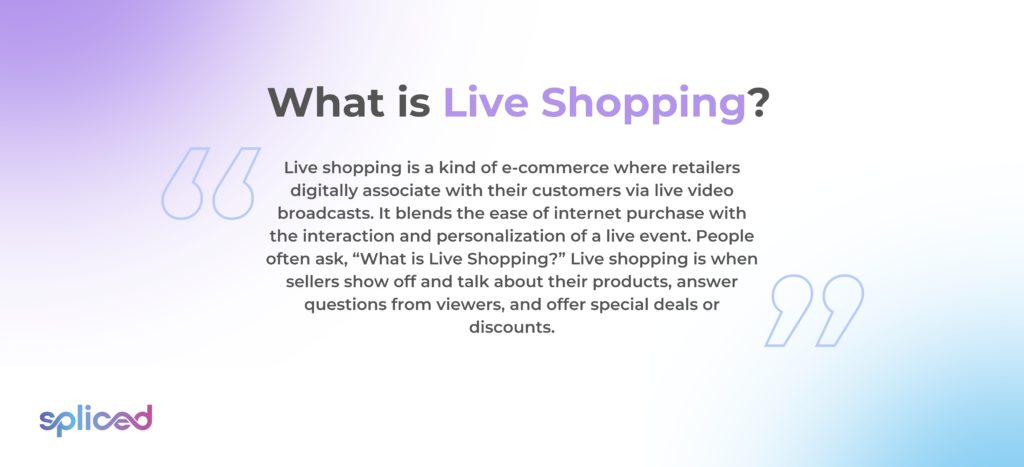
What is Live Shopping?
Live shopping is a kind of e-commerce where retailers digitally associate with their customers via live video broadcasts. It blends the ease of internet purchase with the interaction and personalization of a live event. People often ask, “What is Live Shopping?” Live shopping is when sellers show off and talk about their products, answer questions from viewers, and offer special deals or discounts. Viewers engage with the live broadcast by leaving comments, asking questions, and making purchases. The emergence of social media sites that allow live video broadcasting has contributed to the growth in popularity of live shopping in recent years. It provides a distinct and interactive shopping experience, enabling customers to communicate with sellers and make educated purchase choices in real-time.
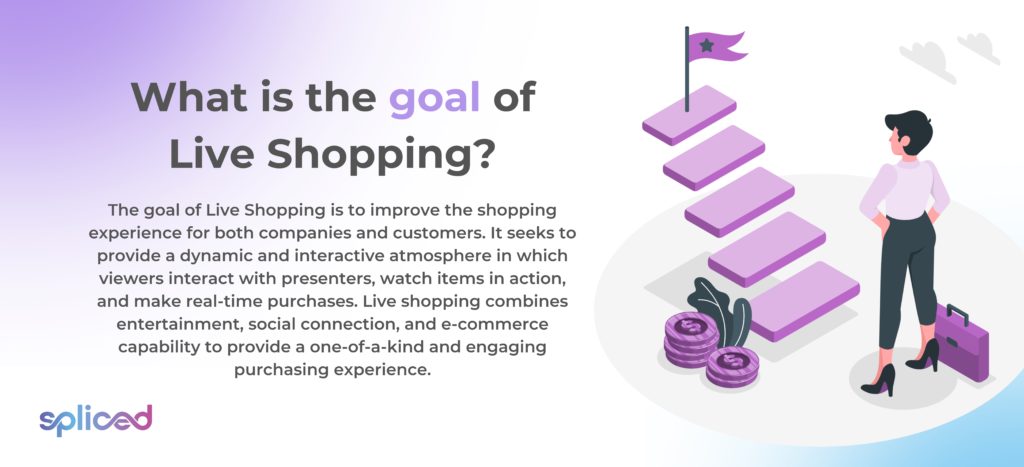
What is the goal of Live Shopping?
The goal of Live Shopping is to improve the shopping experience for both companies and customers. It seeks to provide a dynamic and interactive atmosphere in which viewers interact with presenters, watch items in action, and make real-time purchases. Live shopping combines entertainment, social connection, and e-commerce capability to provide a one-of-a-kind and engaging purchasing experience.
Live shopping for companies aims to create sales, boost brand recognition, and establish consumer loyalty. Brands exhibit their goods or services engaging and participatory by conducting live events or streaming. They show the features and advantages of their products, answer viewer queries, and provide unique bargains or limited-time offers. Live shopping allows brands to obtain immediate product feedback, enabling them to adjust their strategies in response.
Live shopping allows firms to foster community and engage with their customers more personally. Brands create connections and promote brand loyalty by connecting with viewers via comments, likes, and shares. The social component of live shopping makes viewers feel like they are a part of a community and motivates them to share their experiences with others.
The purpose of live shopping for customers is to deliver an interactive and customized purchasing experience. Viewers watch hosts demonstrate items, ask real-time questions, and get rapid replies. Watching live shopping allows viewers to watch the items being used or displayed in real-time, fostering authenticity and confidence. It enables customers to make more educated buying choices by providing a better knowledge of the things before purchasing.
Live shopping is social, as viewers interact with hosts and other viewers. They express their thoughts, request suggestions, and participate in conversations about the items on display. The social interaction adds a fun and exciting aspect to the shopping experience, making it more engaging and memorable.

Is Live Shopping and Livestream Shopping the same?
Yes, live shopping and live streaming are the same. Livestream shopping, often known as live shopping, is a marketing tactic in which a presenter, typically an influencer or celebrity, advertises products via live video. The strategy is comparable to home shopping TV programs in which a person demonstrates product use, but livestream shopping is distinguished by the host’s real-time engagement with the audience.
The presenter of a livestream shopping event promotes items on live video to boost sales. They emphasize the items’ characteristics, advantages, and other relevant information. It allows prospective buyers to discover more about costs and functionality. The host interacts with the audience in real-time, allowing for rapid comments, questions, and demonstrations.
Shopping via Livestream delivers a dynamic and entertaining shopping experience. Viewers participate actively by asking questions, requesting clarification, and getting prompt replies from the presenter. Viewers see the host’s genuine excitement and skill, which generates a feeling of community and confidence. It creates a sense of urgency since viewers make purchases right during the webcast.
Livestream purchasing capitalizes on the host’s influence. Influencers and celebrities often have large followings, and their endorsement of things carries much weight. Hosts influence their audience’s purchase choices by leveraging their brand and authority, increasing sales and brand awareness.

How does Live Shopping work?
Live Shopping works by integrating live video streaming to provide visitors with an engaging shopping experience. It entails a presenter, often an influencer or celebrity, advertising things via live video. The presenter introduces the products, emphasizing their features, advantages, and other pertinent information. It lets prospective clients learn about the items, including price and functionality, in real-time.
Viewers interact with the presenter during a live shopping event. They have the ability to ask questions, seek clarification, and request demonstrations. The host reacts to these conversations, offering rapid responses and answering questions or concerns. The real-time interaction builds camaraderie and trust between the presenter and the audience.
The ability for viewers to make purchases immediately during the live video feed is one of the most critical components of live shopping. The presenter gives viewers with links or other tools to visit the product listings and make their purchases. The quick transactional capacity enhances the buying experience by adding a feeling of urgency and convenience.
The host’s influence is used in Live Shopping. Influencers and celebrities often have devoted fan bases, and their endorsement of items substantially influences purchase choices. The credibility and authenticity that their personal endorsements and demonstrations engender result in greater brand recognition and sales.
Live Shopping combines the power of real-time interaction, live video streaming, and quick purchase possibilities to provide a dynamic and compelling shopping experience. It enables viewers to learn about items, ask questions, and make purchases in real-time, all while benefiting from the host’s influence and expertise.
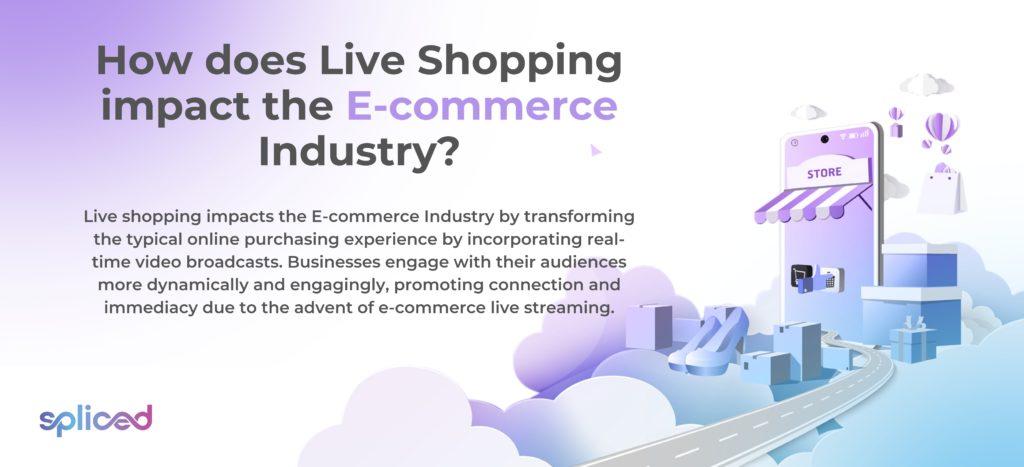
How does Live Shopping impact the E-commerce Industry?
Live shopping impacts the E-commerce Industry by transforming the typical online purchasing experience by incorporating real-time video broadcasts. Businesses engage with their audiences more dynamically and engagingly, promoting connection and immediacy due to the advent of e-commerce live streaming. The novel strategy enables shops to demonstrate items in action, respond to consumer inquiries in real-time, and offer a more customized shopping experience. Live shopping delivers an unparalleled level of consumer engagement, surpassing the capabilities of static product listings and images due to its visual and interactive characteristics.
E-commerce live streaming has shown to be an effective marketing and promotion tool. Brands use live shopping events to debut new items, conduct special deals, and generate enthusiasm about their offers. The real-time aspect of these broadcasts allows companies to capitalize on the feeling of urgency, urging viewers to make on-the-spot purchase choices. The urgency helps to overcome the gap between online and offline retail by creating a social purchasing experience that resembles in-store shopping and allows viewers to connect directly with hosts and other viewers.
Live Shopping helps to boost trust and authenticity in the e-commerce market. Viewers see items used or demonstrated in real-time, resulting in an open and honest presentation. The openness alleviates some of the issues connected with online buying, such as confusion about the quality or look of the goods. The opportunity to ask questions and get rapid solutions fosters consumer-brand trust, generating a more profound feeling of community and loyalty.
Real-time engagement enabled by e-commerce live streams frequently results in increased conversion rates, subsequently impacting sales. An engaging purchasing experience combines visual appeal, interaction, and a direct connection with the audience. Businesses that use live shopping tactics see increased sales and customer retention. It eventually changes the future of e-commerce by changing how people find, connect with, and buy goods online.
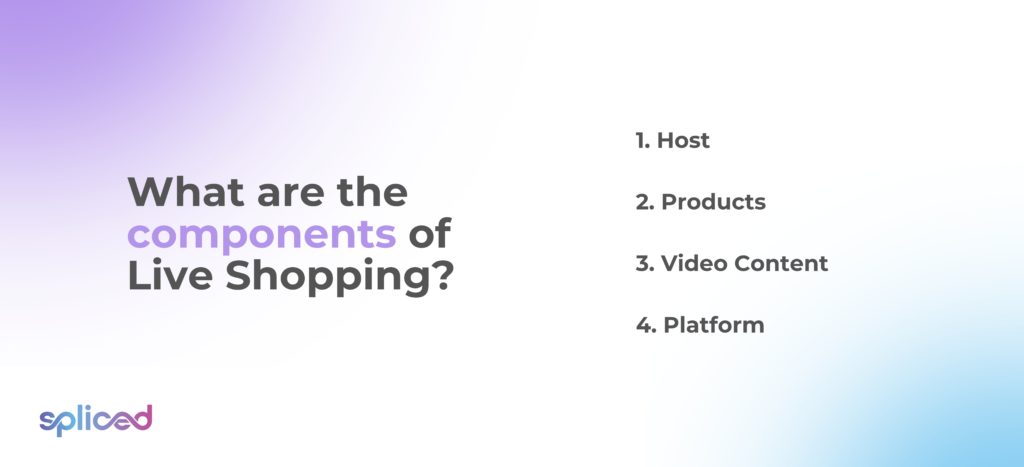
What are the components of Live Shopping?
The components of Live Shopping are listed below.
- Host: The host is the dynamic presenter who directs the live shopping experience. The host’s goal, whether as a brand ambassador, influencer, or knowledgeable corporate representative, is to demonstrate items, connect with viewers, and create an immersive and enjoyable atmosphere. Their ability to properly engage with and connect with the audience dramatically impacts the success of the live shopping session.
- Products: Products are at the center of live shopping. These vary from clothing and cosmetics to technology and home supplies. A live shopping event presents items in real time, enabling viewers to see them in action, ask questions, and make educated purchase choices. The selection and presentation of products are critical in catching the audience’s interest and attention.
- Video Content: Real-time video footage is essential for live shopping. Visuals are vital for displaying product information, exhibiting features, and offering an engaging experience. Video content informs and creates a feeling of immediacy and authenticity since viewers see things being used or discussed in real-time. The live format encourages unplanned encounters, which adds excitement to the purchasing experience.
- Platform: The platform is the digital environment where the live shopping event is held. It is a social networking platform that supports live streaming, a separate live commerce platform, or an integrated feature on an e-commerce website. The platform connects hosts and viewers by providing tools for real-time engagement, product tracking, and frictionless transactions. The platform used dramatically impacts the accessibility, reach, and overall user experience of the live shopping event.
1. Host
A host is a significant individual responsible for managing and enabling the interactive experience between the brand, items, and the audience in Live Shopping. A live stream typically features a charismatic and well-informed presenter who provides real-time product demonstrations and presentations. One of the most critical components of a host’s job is interacting with the audience, answering their questions, sharing wisdom, and creating an enjoyable environment that fosters involvement.
The host serves as a live and active representation of the company, linking the online audience and the exhibited items. They often have product or industry experience, enabling them to provide thorough information and critical insights to prospective consumers. The one-on-one involvement helps to personalize the purchase experience, adding a personal touch that typical e-commerce platforms lack.
The host facilitates the live shopping experience for viewers by exhibiting products, deliberating on their attributes, and promptly responding to any inquiries or remarks from the audience. The interactive style lets customers make better-educated purchase choices since they get instant and individualized solutions to their concerns. The presenter uses engagement methods such as limited-time promos or unique discounts to generate a feeling of urgency and boost purchases during the live broadcast.
Hosts are important as they act as the brand’s face throughout the live broadcast, impacting product perception and the shopping experience. A dynamic, educated presenter captivates the audience, keeping them involved and invested in the live shopping event. The ability of the presenter to interact with viewers, generate trust, and express passion for the items is critical to the success of the live shopping approach.
2. Products
“Products” are the focal point of the Live Shopping experience, acting as the key pieces companies demonstrate and promote during live streaming. Products are things the e-commerce site or business wants to show off and sell to customers. The physical or intangible goods that the e-commerce platform or brand wants to highlight and market to the public are products in the context of Live Shopping. These vary from commodities such as clothing, gadgets, and cosmetics to digital products such as software or online courses. The main feature is that these elements are shown in real time, enabling users to see them in action and interact with the material dynamically.
The live shopping event entails presenters or influencers utilizing a live video broadcast to exhibit and explain various products to the audience. The visual component is essential since it helps viewers see the product’s characteristics, usability, and overall attractiveness dynamically and realistically. Hosts provide thorough explanations, answer viewer queries, and even engage with the items in real-time. The dynamic presentation sets Live Shopping apart from typical e-commerce platforms by offering a more engaging and immersive experience.
Products are important as they are the significant drivers of engagement, conversion, and success in these live events. Businesses generate a feeling of urgency and excitement with live product presentations, prompting viewers to make on-the-spot purchase choices. The interactive aspect of live streaming allows hosts and prospective consumers to communicate directly, allowing for real-time feedback and clarification on product features.
Products in Live Shopping are critical in establishing trust and authenticity. Viewers see how things operate, decreasing ambiguities and anxieties about online purchases. Transparent product demonstrations promote a feeling of credibility, assisting in the establishment of a better relationship between the brand and the audience. The ability to visually check and assess things in real time helps customers make better-informed decisions.
3. Video Content
Video content is an essential component of Live shopping, helping engage viewers and improve the buying experience. Video content refers to real-time visual content streaming in which presenters demonstrate items, engage with viewers, and create a dynamic and immersive experience. It gives consumers a more realistic and detailed representation of products than text-based descriptions or insert images.
Video content is a flexible tool in the Live Shopping environment for product demos, displaying features, and answering client questions. The live and interactive style allows presenters to provide a more in-depth look at the items, stressing their essential features and advantages. The visual attractiveness of video content significantly impacts purchase decisions since customers see how things are utilized or styled in real-time, allowing them to make better-educated judgments.
The method of introducing video material into Live Shopping includes real-time streaming platforms where hosts offer items via live broadcasts. Viewers actively interact in the streaming environment by asking questions, expressing preferences, and making purchases. The rapid and dynamic involvement fosters a feeling of community between the business and the audience, going beyond the transactional aspect of conventional e-commerce.
Video content is essential as it links the online and offline retail experiences, letting customers electronically interact with items and brands like being in-store. Video content’s dynamic and visual nature catches attention, maintains interest, and fosters a more memorable buying experience. The authenticity given by live video enhances confidence by allowing viewers to see real-time interactions and demonstrations, lowering skepticism and uncertainty associated with online transactions.
4. Platform
A platform is the digital infrastructure or online environment where live shopping activities occur in Live Shopping. It is a virtual platform for companies, merchants, and influencers to communicate with their audiences in real-time via video broadcasts. The platform is an integral part of the live shopping experience, as it provides the tools and capabilities required to support interactive sessions, highlight items, and enable frictionless transactions.
Live commerce platforms that operate independently of e-commerce websites and social media platforms are instances of such platforms that have incorporated live broadcast functionalities. Social media platforms such as Instagram, Facebook, and TikTok have grown in popularity for live shopping, enabling companies to utilize their current user bases and communicate with consumers via familiar interfaces. Dedicated live commerce systems like CommentSold and Talkshoplive are built for live shopping experiences, with sophisticated capabilities such as real-time commenting, product tagging, and integrated payment choices.
The platform assumes a critical function in live shopping by facilitating direct communication between presenters and viewers. The participatory aspect of live shopping necessitates real-time comments and queries from viewers, resulting in a dynamic and entertaining experience. The technology gives hosts options to successfully promote items, whether via product labeling, demonstrations, or close-up views, improving the visual attractiveness of the live broadcast.
Live shopping platforms are important as they function as digital shops through which companies successfully express their message, present goods, and engage with their audience. The user interface, functionality, and general design of the platform significantly influence the user experience, impacting how viewers explore the live shopping event and make purchase choices. The platform’s security and payment integration are critical for supporting smooth transactions and maintaining a trustworthy environment for companies and customers.
The platform used significantly impacts the success of a live shopping campaign. It must be relevant to the target audience, provide the elements required for an engaging live shopping experience, and serve the aims of the brands or merchants using the interactive form of e-commerce. Platforms play an increasingly important role in creating the landscape of the creative and dynamic retail model as live shopping evolves.
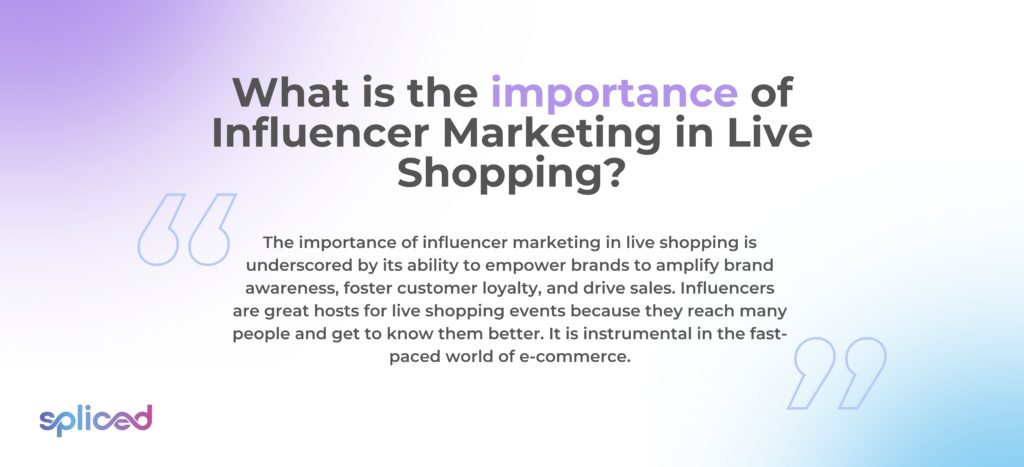
What is the importance of Influencer Marketing in Live Shopping?
The importance of influencer marketing in live shopping is underscored by its ability to empower brands to amplify brand awareness, foster customer loyalty, and drive sales. Influencers are great hosts for live shopping events because they reach many people and get to know them better. It is instrumental in the fast-paced world of e-commerce. The influencer’s existing fan network provides a built-in audience, enabling marketers to tap into a ready-made community of engaged followers. It broadens the reach of the live shopping event and exposes the company to new prospective clients who rely on the influencer’s recommendations.
The collaborative aspect of influencer marketing in live shopping aids in the cultivation of client loyalty. An authentic and relatable element is introduced to the purchasing experience when influencers endorse and interact with products in real time. Viewers often regard the influencer as a reliable source, and their support during live shopping lends legitimacy to the featured items. Authenticity helps develop a stronger connection between the company and the audience, which goes beyond typical advertising tactics.
Influencer marketing has a positive effect on the bottom line by increasing sales. Influencers promote things engagingly and sympathetically, answering viewers’ queries and resolving their issues in real-time. The interactive technique instills a feeling of urgency in viewers, encouraging them to make on-the-spot purchases. The influencer’s function as a presenter adds a personal touch to the shopping experience, making it more entertaining and memorable for the audience. Combining Influencer Marketing with live shopping is, therefore, a vital strategy for boosting sales right away and for making a permanent link between brands and customers in the competitive world of online shopping.
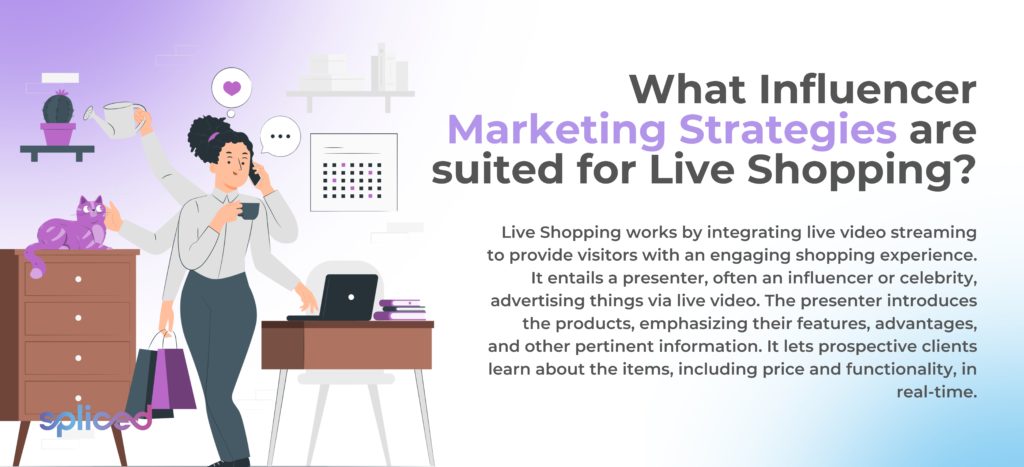
What Influencer Marketing Strategies are suited for Live Shopping?
The influencer marketing strategies suited for live shopping are varied and sophisticated, and they contribute to the success of e-commerce campaigns in a dynamic digital marketplace. The first step is to identify the suitable influencers. The selection process assumes critical importance due to the proliferation of individuals who self-identify as influencers. Prioritize criteria such as the influencer’s congruence with the product, a remarkable rate of interaction that is independent of the number of followers, and a distinct perspective to guarantee a mutually beneficial collaboration.
The second smart thing is to pay attention to micro and nano-influencers. Micro- and nano-influencers often have higher interaction rates than mega-influencers, even though mega-influencers have more followers. These influencers, with followers ranging from 10k to 100k and below 10k, respectively, have a more personal relationship with their audience, resulting in more engagement and perhaps more meaningful brand recommendations.
Another critical tactic is the formation of long-term partnerships. Social media algorithms rely on constant, high-quality material, needing continual collaboration. Establishing long-term partnerships provides consistent material flow, generating several touchpoints between the brand and the customer. The ongoing connection contributes to the long-term development of brand loyalty and credibility.
Authenticity is essential in influencer marketing. Authenticity has emerged as a prominent trend in influencer marketing, with actual, unedited experiences taking precedence over flawlessly produced material. Collaborating with influencers who generate non-obtrusive commercials and sponsored content that showcases the items in a natural atmosphere helps to develop a true relationship with the audience.
Executing a large amount of advertising, such as providing things in return for mentions, is an inexpensive technique, especially with micro and nano-influencers. The strategy is cost-effective and straightforward for influencers to implement. Gifting things in return for mentions corresponds with the collaborative and participatory character of in-person buying, allowing a mutually beneficial connection between influencers and businesses.
The live shopping influencer marketing methods allow organizations to increase brand recognition, create authenticity, and generate meaningful interaction, ultimately establishing their place in the competitive e-commerce industry.
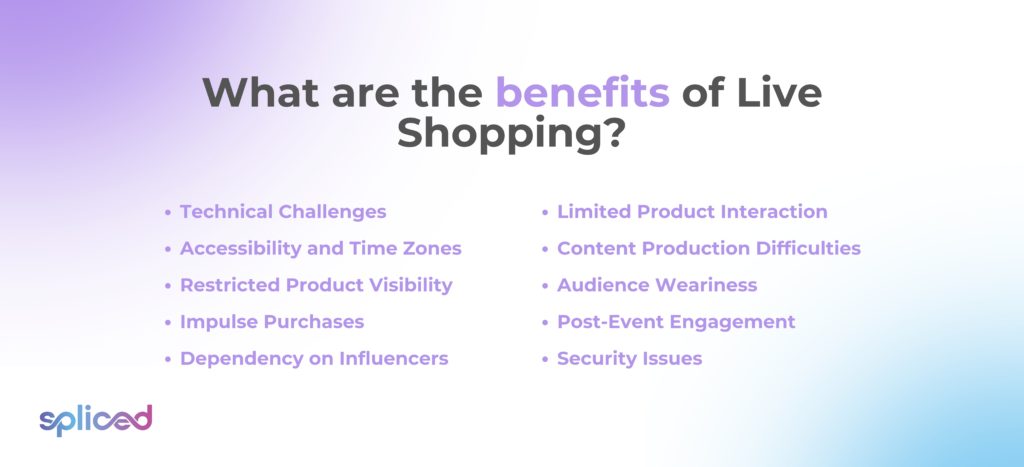
What are the benefits of Live Shopping?
The benefits of Live Shopping are listed below.
- Increased Engagement: Live purchasing elicits greater user involvement and interaction than conventional online shopping. The mix of live video material, interactive features, and the ability for viewers to join in conversations generates a feeling of connection and community, keeping people engaged throughout the event.
- Direct Sales Opportunities: Live shopping effortlessly interacts with e-commerce platforms, allowing viewers to purchase immediately inside the live broadcast. It removes the need for customers to visit a different website, expediting the purchasing process and boosting the possibility of impulsive purchases.
- Authenticity and Transparency: Live shopping lets firms show off their items in action, giving customers a clear picture of their features, usefulness, and look. Authenticity helps customers create trust by allowing them to see how a product functions or appears personally, eliminating doubt and hesitancy in purchasing.
- Insights into Data: Live shopping systems often give valuable data and analytics. Businesses acquire data on viewer engagement, popular goods, and overall performance to make educated decisions and optimize future live shopping campaigns.
- Active Engagement with the Audience: The capacity to engage in real-time dialogue with the audience is a fundamental advantage of live purchasing. Viewers ask questions, get explanations, and get fast replies from presenters or reps, making purchasing more personalized and educational.
- Urgency and Exclusivity: The real-time aspect of live shopping creates urgency and exclusivity. Limited-time promos, special discounts, or exclusive product releases during live events encourage viewers to make rapid purchase choices, capitalizing on the moment and boosting sales.
- Virality and Social Sharing: Live purchasing events are expanded beyond their initial audience by actively sharing viewers on social media platforms. Social sharing improves brand visibility, drawing new consumers and sparking a chain reaction of interest and engagement.
- Entertainment Value: Live events are fun and exciting for people who aren’t buying. The combination of educational information, product demos, and interactive elements offers a distinct sort of entertainment that distinguishes live shopping from standard online retail experiences.
- Collaboration with Influencers: Live shopping is an excellent venue for influencer marketing. Brands and influencers work together to produce live events, using their reach and reputation to present items to a larger audience. The influencer’s endorsement during a live session significantly affects their followers’ purchase choices.
- Opportunities for Cross-Selling: Live shopping events provide a natural atmosphere for cross-selling complementing items. Hosts explain how various things interact with one another or recommend other products that improve the whole experience, possibly raising the average order value.
What are the limitations of Live Shopping?
The limitations of live shopping are listed below.
- Technical Challenges: Live purchasing is highly dependent on technology; therefore, technical malfunctions such as unstable platforms, inadequate internet connectivity, or video buffering cause interruptions to the live stream. These difficulties result in a less-than-ideal viewing experience for both presenters and spectators.
- Accessibility and Time Zones: The accessibility of live purchasing events is compromised for specific individuals as a result of disparities in time zones. Viewers in various parts of the world find it challenging to engage in real-time, perhaps alienating a segment of the intended audience. Brands must recognize their audience’s global character and prepare appropriately.
- Restricted Product Visibility: One or a few products are frequently the focal point during a live purchasing session. It results in a brand’s complete product line having restricted exposure. Viewers lose out on other items that are of interest to them, thus resulting in lost sales chances.
- Impulse Purchases: Live shopping’s feeling of urgency encourages impulsive purchases, but it causes regret on the part of the consumer. Viewers make rash judgments during the live event that they later regret, lowering the return rate and overall consumer satisfaction.
- Dependency on Influencers: The popularity and efficacy of the influencer as a presenter has a direct effect on the campaign’s performance if live shopping events are primarily hosted by them. Problems with the influencer’s reputation or performance harm the brand’s image.
- Product Interaction is Limited: Viewers are limited to the information and demonstrations presented during the live event. Live shopping provides a more restricted degree of involvement with the featured items than in-store shopping, where buyers physically touch and try out the products.
- Content Production Difficulties: Creating compelling and high-quality live content requires preparation and resources. Brands have difficulty organizing exciting live shopping events, particularly if they lack the essential expertise or the process is time-consuming.
- Audience weariness: Attending too many live shopping events from the same company or influencer causes audience weariness. Viewers lose interest if the information gets repeated, reducing the efficiency of the live shopping approach.
- Post-Event Engagement Engagement: A decline in engagement is commonly observed after the conclusion of a live purchasing event. Live shopping events have a short shelf life, so businesses must constantly provide fresh material to keep consumers interested. It contrasts regular social media postings, which people find over time.
- Security Issues: Data privacy and safe payment processing are critical when live shopping incorporates transactions. Brands must ensure their platforms offer a safe environment for financial transactions while protecting client data.
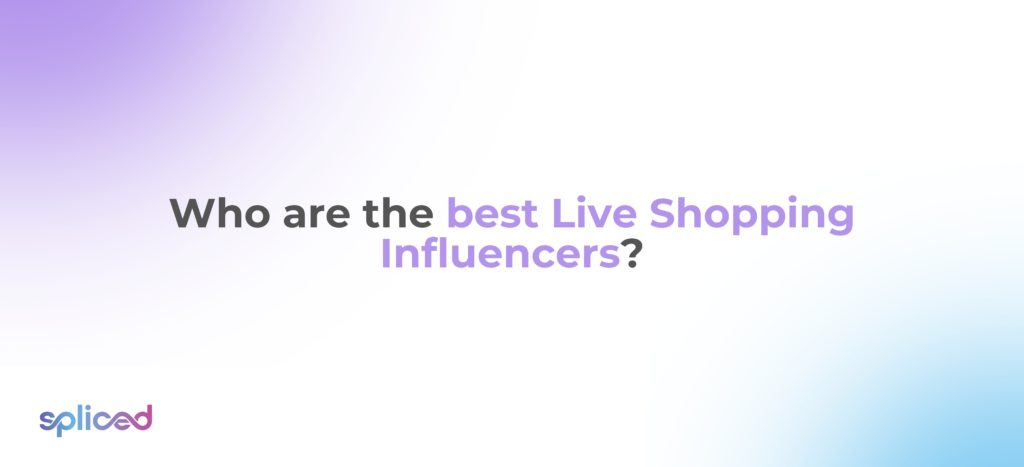
Who are the best Live Shopping Influencers?
The best live shopping influencers are listed below.
- Renaud Bauer: Renaud Bauer is a self-taught metal fan who lives in the French Alps and has a YouTube channel with 72,000 followers. Bauer’s live shopping effort centered on tools and construction materials for the Batimat brand, releasing new items after an exhibition. Bauer’s experience in welding and metalwork brings a distinct perspective to the live retail scene despite his relatively tiny social media following.
- Leomie Anderson: Leomie Anderson, a British model and activist, participated in Tommy Hilfiger’s Instagram live shopping session. Anderson’s participation in the Victoria’s Secret shopping livestream, discussing trends and style as a Victoria’s Secret Angel, demonstrated the convergence of fashion, modeling, and live shopping. Anderson’s presence elevates the live shopping experience by providing insights into the world of high-end fashion.
- Laura Clery: Laura Clery, renowned for her comic skits, has 15 million Facebook followers, 3 million Instagram followers, 873,000 YouTube subscribers, and 6.7 million TikTok subscribers. Clery is funny and has tried live shopping by making a brand called Boibs after being mocked online. Laura Clery goes over just advertising her company, as seen by her Facebook Live video promoting the mobile game Best Fiends.
- Carla Stevenne: Beauty expert and makeup artist Carla Stevenne, who has 251,000 followers on her YouTube channel BeautyByCarla, has carefully used Amazon Live. Stevenne has 81,500 Instagram followers and has built an enormous collection of live shopping videos connecting to numerous cosmetic goods on Amazon. Stevenne’s achievement highlights the power of using e-commerce behemoths for in-person buying.
- Gabby Morrison: TikTok influencer Gabby Morrison, who has 3.7 million TikTok followers and 347,000 Instagram followers, took part in Walmart’s live shopping experience. Walmart collaborated with TikTok producers for a live shopping event where Morrison and others displayed beauty selections, skincare regimens, and hot-trend tips. Morrison’s participation emphasizes merging social media platforms and retail behemoths in live shopping.
- Natalie Lim Suarez and Dylana Lim Suarez: Natalie Lim Suarez and Dylana Lim Suarez, fashion influencers renowned for their blogs and Instagram presence, conducted a live shopping broadcast for Luisaviroma at New York Fashion Week. The sisters gave fans an inside look into their fashion event preparations, including traversing the streets of New York and chatting with viewers. The cooperation demonstrates how influencers merge live shopping with significant fashion events and unique collaborations.
- Ree Drummond: Ree Drummond, often known as The Pioneer Woman, is an American blogger, novelist, and television personality with 4.2 million Instagram followers. Drummond worked with Walmart on live shopping promotions for the Pioneer Woman Collection. Drummond’s involvement enabled viewers to buy the clothing shown during the live broadcast, showcasing the seamless integration of live shopping with retail relationships.
- Sarah Nicole Landry: Sarah Nicole Landry, commonly known as @thebirdspapaya, a digital creative with 2.2 million Instagram followers, hosted a live shopping event for Canadian intimates manufacturer Knix. Landry’s live broadcast for Knix’s swimsuit debut included social media methods, online surveys, and clear buying channels. Landry’s genuineness, especially in recording her weight reduction progress, gives the live shopping experience a natural touch.
- Itsjudytime (Judy Travis): Judy Travis oversees the illustrious beauty-focused influencer Itsjudytime, which amasses a considerable following across multiple platforms (3 million on Facebook, 837,000 on Instagram, and 1.26 million on YouTube). Travis took part in a Facebook Live shopping promotion for Kohls on Black Friday, displaying her shopping experience and Christmas purchases and giving viewers a personal and interactive look at her holiday buying selections.
- Nate Wyatt: TikTok phenomenon Nate Wyatt, who has 6.2 million TikTok followers and a significant presence on other platforms, collaborated with Aldo for a live shopping broadcast. Wyatt collaborated with celebrity stylist Mimi Cuttrell to suggest fashion and show off Aldo’s spring 2021 collection. The 308% engagement rate demonstrates the power of influencers like Wyatt in boosting interaction and purchases during live shopping events.
- Jamie Yeo: Jamie Yeo, a well-known Singaporean with 110,000 Instagram followers and 33,000 on Facebook, has taken on the Instagram Live Shopping Influencers position. Yeo offered skincare and life ideas with other influencers, highlighting Lancôme Advanced Génifique products. Yeo’s transformation from a television household figure to a social media counselor and influencer exemplifies the adaptability of live retail influencers.
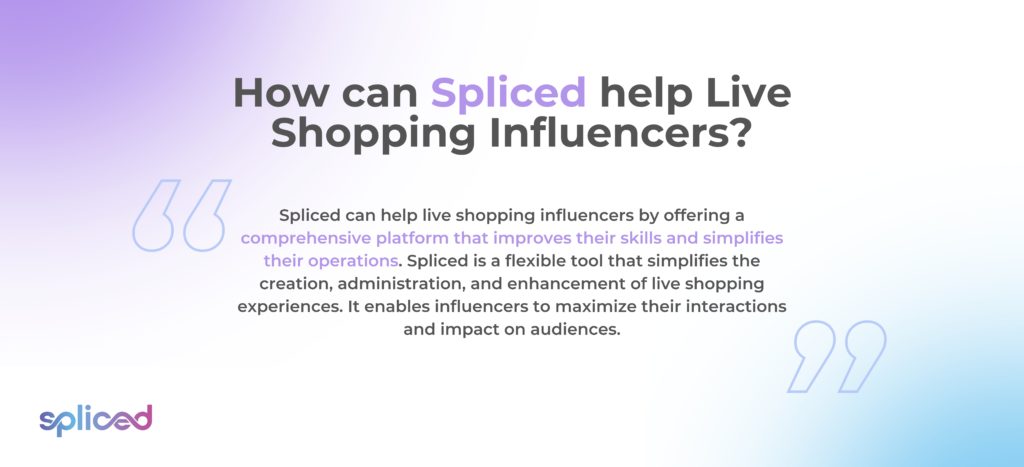
How can Spliced help Live Shopping Influencers?
Spliced can help live shopping influencers by offering a comprehensive platform that improves their skills and simplifies their operations. Spliced is a flexible tool that simplifies the creation, administration, and enhancement of live shopping experiences. It enables influencers to maximize their interactions and impact on audiences.
Influencers who organize live shopping sessions benefit greatly from Spliced’s user-friendly interface, which simplifies the process of planning and executing live shopping sessions. The platform offers user-friendly tools that allow influencers to include interactive elements, promotions, and product highlights in their video creation. It results in a dynamic and engaging live shopping experience.
Influencers efficiently manage their live shopping content using Spliced’s capabilities, which include statistics and performance indicators. The data-driven approach allows influencers to assess the effectiveness of their sessions, understand audience behavior, and make informed decisions to optimize future in-person purchasing experiences.
Spliced offers similarly flexible advertising possibilities, allowing influencers who promote live purchasing to grow their audiences. Influencers that use Spliced’s marketing tools increase their visibility, get more followers, and ultimately increase the success of their live shopping campaigns.
Spliced recognizes the need for collaboration among influencers. The platform allows influencers and businesses to develop relationships and foster mutually beneficial connections. Spliced allows live shopping influencers to interact with brands, searching for innovative ways to showcase their products during live sessions. It opens up new channels for generating revenue and forming brand alliances.
Influencers that support live shopping effectively use Spliced as a helpful tool. It offers various features and resources to facilitate video creation, enhance performance evaluation, and promote brand collaboration. Live shopping influencers use Spliced’s capabilities to increase their online presence, effectively engage audiences, and benefit from the growing live shopping trend in the quick-paced world of e-commerce.
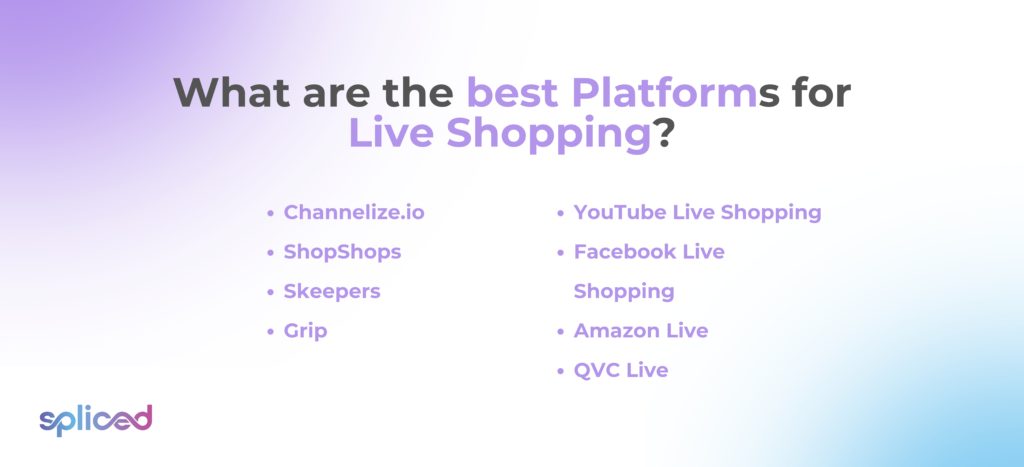
What are the best Platforms for Live Shopping?
The best platforms for live shopping are listed below.
- Channelize.io: It is a complete live shopping platform with various features. It offers powerful features for staging live shopping events, connecting with audiences, and ensuring smooth transactions. The platform is recognized for its adaptability and is appropriate for various organizations wishing to use live shopping.
- ShopShops: It distinguishes itself with its focus on partnerships with influencers. The platform enables influencers to arrange live shopping events, offering advertisers a unique chance to reach the influencer’s following. The collaborative strategy broadens the reach and efficacy of live shopping promotions.
- Skeepers: It provides a live shopping platform emphasizing improving the consumer experience. The platform offers resources for smooth live shopping interactions, making it an enticing solution for organizations looking to develop compelling and user-friendly live buying experiences.
- Grip: A live shopping platform that aims to create a dynamic and immersive purchasing experience. It focuses on elements that increase viewer engagement, making it ideal for companies creating dynamic and visually attractive live shopping events.
- YouTube Live Shopping: It is a live shopping event that uses the ubiquitous video platform YouTube. It is well-known for its cross-channel live redirection, which allows companies to engage in real-time with their YouTube audience, providing a smooth transition between content and buying experiences.
- Facebook Live Shopping: It is a dynamic platform that is used by a wide range of companies. It uses Facebook’s large user base to offer live shopping events. Businesses promote items and interact with their audience with integrated shopping options, building a direct link between content and commerce.
- Amazon Live: It is designed exclusively for Amazon shop owners. It connects with the Amazon ecosystem effortlessly, enabling merchants to promote and sell items in real-time. The tool improves Amazon consumers’ purchasing experiences via live demos and interactions.
- QVC Live: It distinguishes itself by offering access to skilled presenters. The site is well-known for its professional approach to live shopping, with presenters leading viewers through product demos and providing a fun shopping experience. It is ideal for organizations seeking a skilled and authoritative live retail presence.
- NTWRK: It is a live shopping platform that gives a curated and one-of-a-kind purchasing experience. It often provides exclusive drops, limited editions, and partnerships with influencers and celebrities, making it a popular platform for individuals looking for unique and trendsetting items.
- Instagram Live Shopping: It leverages Instagram’s popularity for real-time shopping events. It helps influencers and marketers exhibit items and facilitate direct purchases inside the Instagram platform by integrating with the network’s enormous user base.
- Livescale: A live retail platform specializing in high-quality, interactive live-streaming experiences. It is well-known for its professional production skills, making it an excellent choice for companies offering polished and entertaining live shopping events.
- CommentSold Live: It is well-known for its ability to cross-stream. Businesses use the platform to enhance their live shopping reach by concurrently broadcasting over various channels. Its function increases exposure and interaction, allowing one to reach a larger audience.
- Talkshop.live: It is a live shopping platform that stands out for its pre-paid shipping notifications. It offers solutions to improve the post-purchase experience by providing clear shipment notifications, resulting in a happy and trustworthy buying experience.
- Bambuser Live Video Shopping: It is well-known for its many integrations. The platform interfaces smoothly with various e-commerce and business technologies, providing a complete solution for companies wishing to improve their live shopping capabilities via integrations.
- GoLive: It distinguishes itself as an AI-powered live shopping platform. It uses AI to improve the live shopping experience by providing tailored suggestions, targeted interactions, and data-driven insights. The AI-driven strategy attempts to improve engagement and sales results.
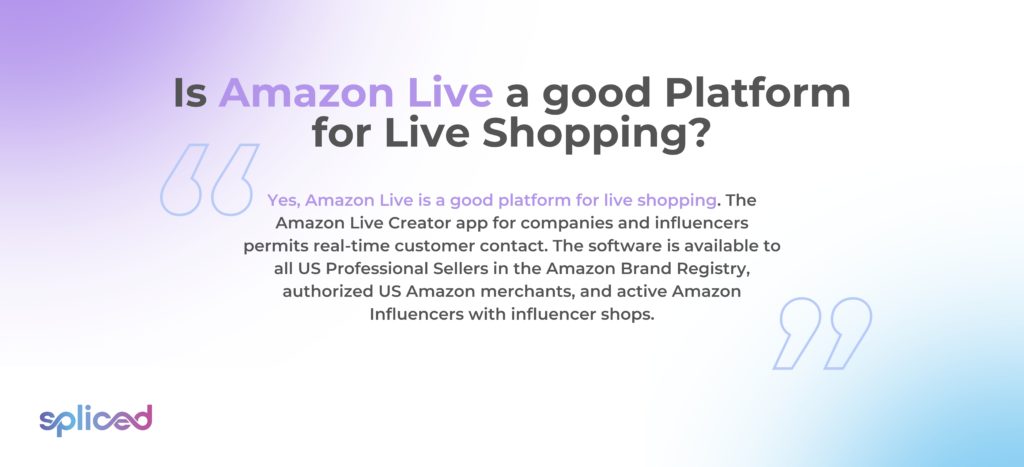
Is Amazon Live a good Platform for Live Shopping?
Yes, Amazon Live is a good platform for live shopping. The Amazon Live Creator app for companies and influencers permits real-time customer contact. The software is available to all US Professional Sellers in the Amazon Brand Registry, authorized US Amazon merchants, and active Amazon Influencers with influencer shops.
Qualified users utilize Amazon Live to communicate with their audience via interactive livestreams, updating followers in real-time via the Amazon mobile purchasing app (currently only accessible on iOS devices). The primary attributes of the platform consist of metrics provision, live promotions, messaging functionality, and product highlighting.
Amazon Live combines the fun and interactivity of live video with the ease of online purchasing, enabling companies and influencers to present their items inside the product carousel dynamically. The integration improves the whole purchasing experience and directly links vendors and their customers.
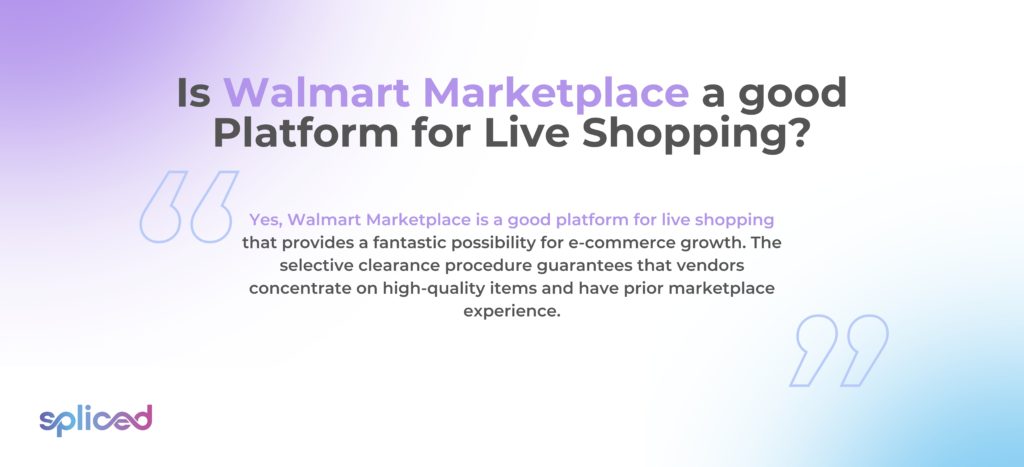
Is Walmart Marketplace a good Platform for Live Shopping?
Yes, Walmart Marketplace is a good platform for live shopping that provides a fantastic possibility for e-commerce growth. The selective clearance procedure guarantees that vendors concentrate on high-quality items and have prior marketplace experience.
Walmart has prioritized consumer and merchant confidence as a fundamental aspect of its business approach ever since the inception of e-commerce in 2000. Its commitment has been maintained since the platform’s expansion to accommodate third-party vendors in 2009.
Walmart Marketplace fosters customer happiness by offering high-quality products and a first-rate shopping experience. The platform caters to a wide range of preferences by allowing consumers to purchase in-store, online, or via the Walmart mobile app.
Price continues to be an important conversion driver, and Walmart stresses Every Day Low Price (EDLP) as a cornerstone strategy. Various tools and dashboards, such as the Pricing Opportunities dashboard and the Repricer tool, help Walmart Marketplace vendors align with the goal and easily earn the Buy Box.
Sellers increase their chances of conversion by enrolling in Walmart Fulfillment Services (WFS) and providing rapid and free shipment. The service includes Two-Day Delivery and Fulfilled by Walmart tags, which improves product exposure and conversion rates. WFS guarantees two-day delivery throughout the continental United States, exceptional client service, and access to strategic advising services.
Walmart Marketplace’s commitment to trust and safety, along with features such as the Free & Easy Returns program and a promise to rapid delivery, presents it as a viable live shopping platform that generates growth and nurtures repeat consumer loyalty.
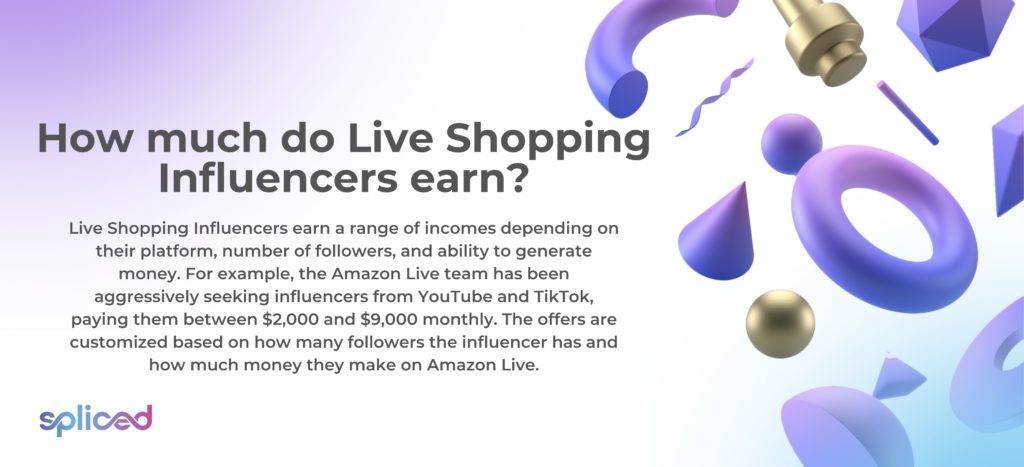
How much do Live Shopping Influencers earn?
Live Shopping Influencers earn a range of incomes depending on their platform, number of followers, and ability to generate money. For example, the Amazon Live team has been aggressively seeking influencers from YouTube and TikTok, paying them between $2,000 and $9,000 monthly. The offers are customized based on how many followers the influencer has and how much money they make on Amazon Live. Users of TikTok with 100,000 or more followers get up to $9,000 a month, subject to revenue objectives and livestreaming obligations. Another offer was made to a million-subscriber YouTuber: $9,000 in exchange for a certain livestream commitment, or $5,000. These offers are on top of the regular commission rate that Amazon Live charges, which ranges from 1 to 10%.
The average influencer across all platforms makes $31 an hour, according to data from the influencer business. The average hourly wage for mega-influencers is $187, but they demand far greater salaries, especially for individuals involved in live purchasing experiences. The influencer’s specialization, follower engagement, and amount of effort spent on account maintenance are all factors that affect their profits. Live Shopping Influencers’ sources of income are varied via commission rates, sponsored content, and brand collaborations, with potential profits varying depending on their negotiation power and the efficiency of their live shopping engagements.
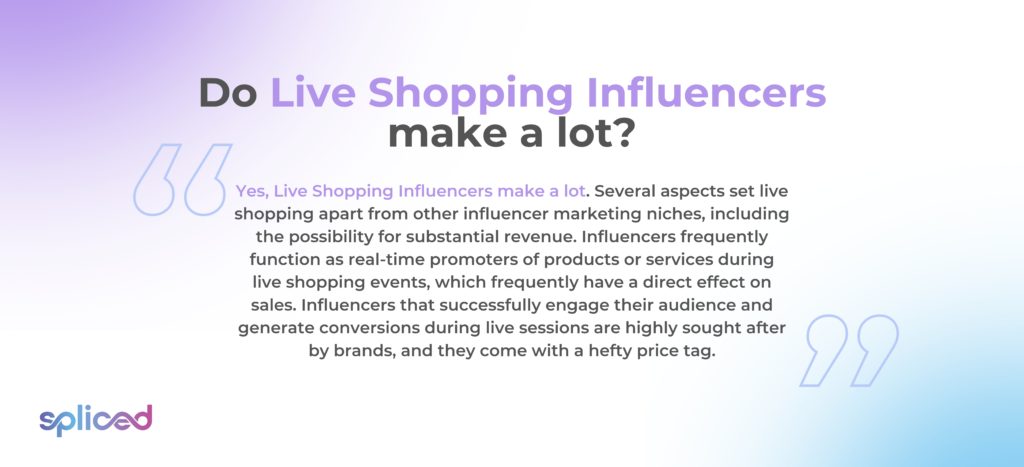
Do Live Shopping Influencers make a lot?
Yes, Live Shopping Influencers make a lot. Several aspects set live shopping apart from other influencer marketing niches, including the possibility for substantial revenue. Influencers frequently function as real-time promoters of products or services during live shopping events, which frequently have a direct effect on sales. Influencers that successfully engage their audience and generate conversions during live sessions are highly sought after by brands, and they come with a hefty price tag. Live shopping is participatory, which means that customers provide instant feedback and feel pressured to make a purchase. The environment encourages impulsive purchases. The lucrative nature of influencer revenues in live shopping is further enhanced by commission systems, sponsorship agreements, and brand collaborations. These elements work together to make live shopping a very successful strategy within the larger influencer marketing space, as does the influencers’ capacity to establish rapport and trust with their audience.
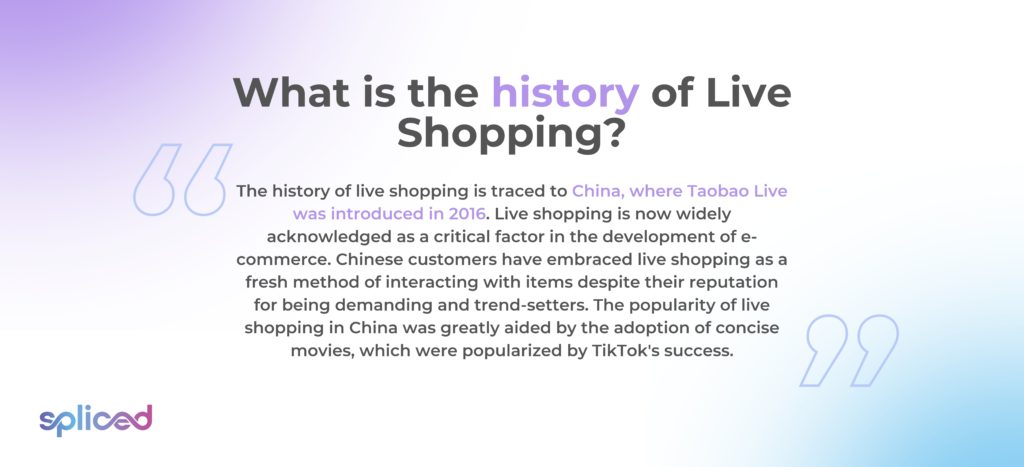
What is the history of Live Shopping?
The history of live shopping is traced to China, where Taobao Live was introduced in 2016. Live shopping is now widely acknowledged as a critical factor in the development of e-commerce. Chinese customers have embraced live shopping as a fresh method of interacting with items despite their reputation for being demanding and trend-setters. The popularity of live shopping in China was greatly aided by the adoption of concise movies, which were popularized by TikTok’s success.
The third-biggest Chinese online marketplace, Pinduoduo, added to the history of livestream shopping by using a group-buying-based business strategy that leverages buddy networks to activate exclusive deals. The emergence of live purchasing prompted businesses in Western Europe and the United States to investigate the phenomenon, which gained prominence in these regions as TikTok’s popularity increased.
“Style Code Live” was Amazon’s first attempt at live shopping, launched in March 2016, and it used live streaming to advertise fashion items that were only available on Amazon. Amazon Live, which lets sellers host live shopping streams directly on Amazon’s platform, was a later success after its initial failure. Instagram and Facebook quickly followed suit, launching live shopping services in the second half of 2020. The integration of live shopping into major e-commerce and social media platforms was highlighted by the notable initiatives of Instagram’s Live Shopping and Walmart and TikTok’s partnership.
Live shopping gained popularity in Latin America when Grupo Éxito, the biggest retailer in Colombia, organized a successful live shopping event in 2020 with the help of VTEX. The adoption of live shopping as a fundamental e-commerce tactic in the area began with this event. Latin America was ready for this trend, as shown by the success of live shopping events with partners like Xiaomi, BSoul, Agua Bendita, and Samsung.
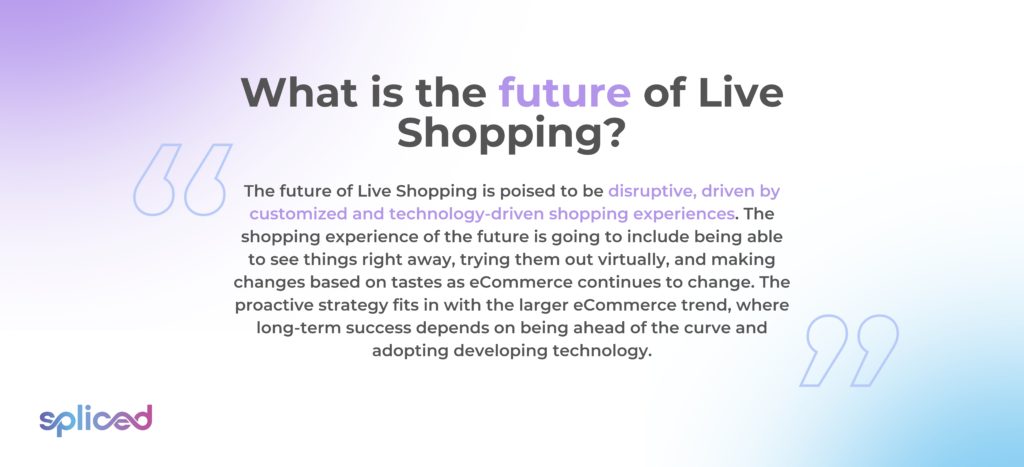
What is the future of Live Shopping?
The future of Live Shopping is poised to be disruptive, driven by customized and technology-driven shopping experiences. The shopping experience of the future is going to include being able to see things right away, trying them out virtually, and making changes based on tastes as eCommerce continues to change. The proactive strategy fits in with the larger eCommerce trend, where long-term success depends on being ahead of the curve and adopting developing technology.
Customers must expect more sophisticated and immersive live-streaming experiences in the next few years, which is going to increase the allure and engagement of shopping. The development is anticipated to provide new features that are beyond the capabilities of conventional online buying and improve the live purchasing experience overall. Technology integration is going to provide customers with an accessible and engaging buying experience with features like immediate personalization and virtual try-ons.
Live shopping is already included in various eCommerce techniques, including conventional auctions held by prestigious organizations like Christie’s and on sites like Whatnot. The popularity of live shopping and its widespread interest among major companies point to a bright future for the movement. Businesses are investigating new resources and channels, such as the metaverse, to expand the reach and allure of live shopping as it becomes a standard component of eCommerce plans.
The trajectory of Live Shopping indicates that it is going to become a mainstay of the eCommerce scene, helped by creative thinking from businesses throughout the globe as well as customer demand. Future shopping experiences are expected to be dynamic and technologically sophisticated, with live shopping having a significant influence on how customers engage with and make choices about what to buy in the online marketplace.
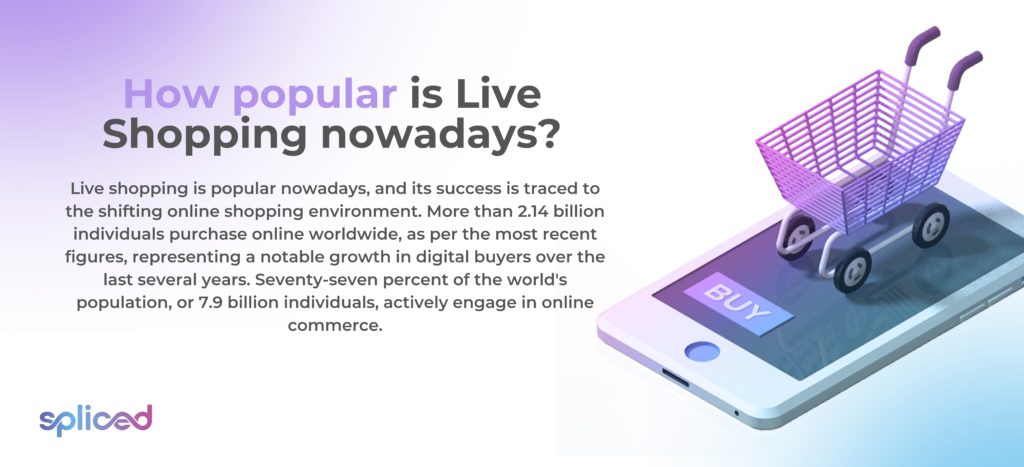
How popular is Live Shopping nowadays?
Live shopping is popular nowadays, and its success is traced to the shifting online shopping environment. More than 2.14 billion individuals purchase online worldwide, as per the most recent figures, representing a notable growth in digital buyers over the last several years. Seventy-seven percent of the world’s population, or 7.9 billion individuals, actively engage in online commerce.
The rise in e-commerce is ascribed to the changing methods companies use to provide their clients with experiences. More immersive and engaging techniques have replaced traditional online selling strategies, with live shopping becoming a major trend. Customers interact with items and brands in real-time with live shopping, which differs from traditional online retail. Live shopping is dynamic and engaging.
A significant 40% of customers in East Asian nations like China and 17% of American consumers are actively engaged in the live shopping trend, which is especially gaining pace. The allure of live shopping is its capacity to seamlessly combine frictionless shopping with human connection, giving customers a unique and captivating experience. The fact that live shopping has become more popular since COVID-19 and is now a crucial component of peoples’ shopping experiences is evidence of its ascent.
The fundamental reason for live purchasing’s surge in popularity is its ability to revolutionize the online shopping experience by offering customers a more immersive and participatory method of exploring and acquiring products. The development signifies a more extensive transformation in consumer conduct toward online retail experiences that are more dynamic and immersive.
